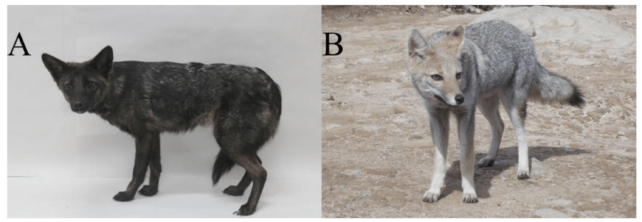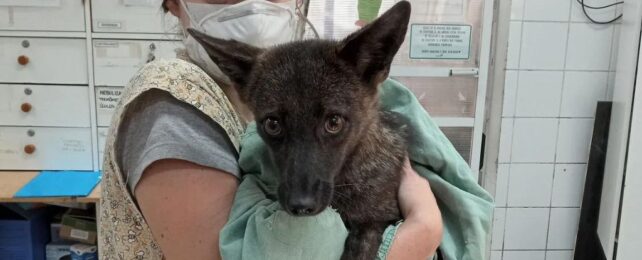A stray canine in Brazil has turned out to be a whole new breed of adorable. According to a genetic study, the female animal is most probably the first of its kind – a hybrid between a South American pampas fox and a dog. Otherwise known as a dogxim.
From the very start, its appearance and behavior baffled scientists. The animal wasn't like any canine they had seen before. It barked like a dog, and its eyes and dark fur looked like those of a dog, but its pointed ears and long snout suggested otherwise.
It also wouldn't eat dog food, only small rats.
"It was not as docile as a dog, but it also lacked the aggressiveness expected of a wild canid when handled," a conservationist who helped care for the creature told The Telegraph.
The curious creature was initially found back in 2021, having been severely injured after a road collision in Vacaria, Rio Grande do Sul. It was nursed back to health at the Center for Conservation and Rehabilitation of Wild Animals at the Federal University of Grande do Sul.
This region of South America is known to host four species of canid, and yet none of these specific animals match up with the rescued canine in appearance or genetics.
Local bush dogs (Speothos venaticus) have small rounded ears, short legs, and brown fur.
Whereas the maned wolf (Chrysocyon brachyurus) is quite tall with long legs and ears and a reddish-brown coat.
The crab-eating fox (Cerdocyon thous) and the pampas fox (Lycalopex gymnocercus) are closest in appearance to the rescued animal, although their fur is lighter in color. In spite of their names, neither is closely related to European foxes, being a little more closely related to dogs.
With no one species fitting the bill, researchers in Brazil turned to the idea of a crossbreed.
Genetic evidence from the rescued creature suggests it is, in fact, a hybrid between a pampas fox and a domestic dog – an extremely rare occurrence of two species from different genera reproducing.
"This discovery implies that, although these species diverged about 6.7 million years ago and belong to different genera, they might still produce viable hybrids," the researchers write.

The rescued animal was found to possess 76 chromosomes in total, and these chromosomes had a similar visual appearance to those of domestic dogs and the pampas fox.
What's more, pampas foxes have 37 pairs of chromosomes, which could rearrange with a dog's genome to leave 38 pairs.
While it's still not the same as the dog's 39 pairs, the genetic similarities just might allow for rare combinations of DNA that actually work.
The rescued canid also has two X chromosomes with two different morphologies, which indicates they came from two different species.
An analysis of the creature's mitochondrial DNA, which only comes from the maternal side, suggests its mother was probably the pampas fox and its father was a dog.
"So far, we have no scientific evidence that there are other hybrids in this region. However, we suspect that this case we have described is not the only one," Bruna Szynwelski told Newsweek.
"Once biologist Herbert Hasse Junior observed two animals with an unusual phenotype in nature in 2019, it is likely that one of these animals was the female hybrid that was run over in 2021, and the other animal was never seen again."
In a cruel twist to the story, the dog-fox hybrid apparently died under unknown circumstances at a zoo after recovering from its injuries.
According to reporting by The Telegraph, authorities are now investigating how and why this unique creature passed away.
The study was published in Animals.
